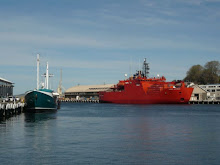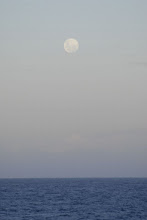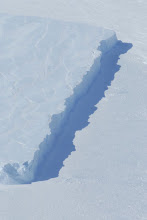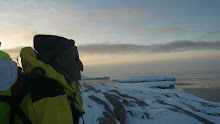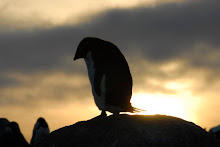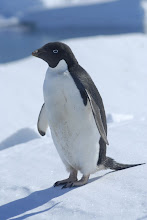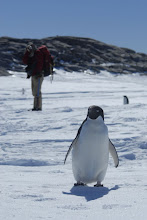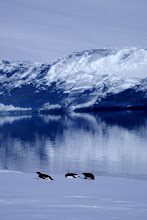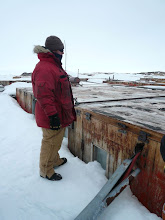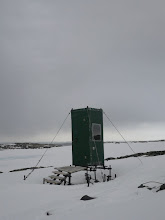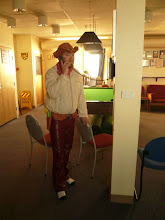 Field training, as I mentioned, prepares us for travelling off station on jollies by teaching us “vital skills, essential for travel within Antarctica”. Most of what we were taught is common sense or skills most people should already know (navigating by compass, how to set up a tent, how to light a gas stove), but as usual it seems to be more about making us accountability for our actions than anything. Having said this we did learn some interesting things; things it is pretty hard to learn elsewhere, like ice-walking with instep cramp-ons, bivvying in a near blizzard, and sea-ice travel.
Field training, as I mentioned, prepares us for travelling off station on jollies by teaching us “vital skills, essential for travel within Antarctica”. Most of what we were taught is common sense or skills most people should already know (navigating by compass, how to set up a tent, how to light a gas stove), but as usual it seems to be more about making us accountability for our actions than anything. Having said this we did learn some interesting things; things it is pretty hard to learn elsewhere, like ice-walking with instep cramp-ons, bivvying in a near blizzard, and sea-ice travel.  As tame as that slope looks, its hard to explain just how slippery a hill of ice really is. I actually took a tumble or two, which may or may not have been intentional.
As tame as that slope looks, its hard to explain just how slippery a hill of ice really is. I actually took a tumble or two, which may or may not have been intentional.  Our main mode of transport for jollies is quad bikes. They work surprisingly well on snow, and absolutely terribly on ice… what a surprise. But that doesn’t mean they aren’t still great fun.
Our main mode of transport for jollies is quad bikes. They work surprisingly well on snow, and absolutely terribly on ice… what a surprise. But that doesn’t mean they aren’t still great fun.  Here we are travelling on a large piece of sea-ice (above). The recommendations for ice thickness in terms of sea-ice travel are 20cms for pedestrian travel, 40cms for quad bikes, and 60cms for a hagglunds. I tend to err on the side of caution with these figures, maybe its just me, but I like the concept of self-preservation.
Here we are travelling on a large piece of sea-ice (above). The recommendations for ice thickness in terms of sea-ice travel are 20cms for pedestrian travel, 40cms for quad bikes, and 60cms for a hagglunds. I tend to err on the side of caution with these figures, maybe its just me, but I like the concept of self-preservation.  We hand-drill down to test sea-ice thickness every few hundred meters.
We hand-drill down to test sea-ice thickness every few hundred meters.Our first night of training was spent at the abandoned American station Wilkes. It is just across the bay from Casey (3kms directly) and was abandoned because it is basically situated in the middle of a very large blizz-tail.
 Removing the snow that built up around the buildings just got too much so they gave it to the Australians, and we relocated it. Wilkes is an interesting time warp because all that’s left is the tops of the old buildings (buried under snow) and lots of random ‘junk’ like broken wooden crates, rusty nails, old metal pipes, which must be left in place since the whole area is now heritage listed.
Removing the snow that built up around the buildings just got too much so they gave it to the Australians, and we relocated it. Wilkes is an interesting time warp because all that’s left is the tops of the old buildings (buried under snow) and lots of random ‘junk’ like broken wooden crates, rusty nails, old metal pipes, which must be left in place since the whole area is now heritage listed.  However the main reason people visit Wilkes from Casey is to stay at the “Wilkes Hilton”. This is an authentic Antarctic building (built in the early 50’s), which contains the ONLY wood fire on Australian/Antarctic land. Of the 3 or 4 ‘field huts’ people from Casey can visit on jollies this is the most luxurious… hence the name.
However the main reason people visit Wilkes from Casey is to stay at the “Wilkes Hilton”. This is an authentic Antarctic building (built in the early 50’s), which contains the ONLY wood fire on Australian/Antarctic land. Of the 3 or 4 ‘field huts’ people from Casey can visit on jollies this is the most luxurious… hence the name. 
 Despite the 4 beds inside however, we bivvied out this night as part of our training. A bivvy bag consists of a windproof sack (a little bigger than a sleeping bag) with a foam mat rolled up inside. The idea is that if you get stuck in the field and the weather closes in, it may be safer to stay put and wait for help or the weather to clear, which may be 2 or 3 days... Bivvying is a warm and dry alternative to standing around in a blizzard.
Despite the 4 beds inside however, we bivvied out this night as part of our training. A bivvy bag consists of a windproof sack (a little bigger than a sleeping bag) with a foam mat rolled up inside. The idea is that if you get stuck in the field and the weather closes in, it may be safer to stay put and wait for help or the weather to clear, which may be 2 or 3 days... Bivvying is a warm and dry alternative to standing around in a blizzard.  That techni-coloured blob is actually one of our plumbers, Wayne, inside his bivvy.
That techni-coloured blob is actually one of our plumbers, Wayne, inside his bivvy. 
 When you bivvy everything goes in. There isnt too much room, and its hard to organise things in a stong wind, but once youre sorted its ok. Of course, where every other field training party had warm nights and no wind for their bivvying, we had 25-30 knots and blowing snow. But despite all this I slept quite well that night, and had to be woken up the next morning.
When you bivvy everything goes in. There isnt too much room, and its hard to organise things in a stong wind, but once youre sorted its ok. Of course, where every other field training party had warm nights and no wind for their bivvying, we had 25-30 knots and blowing snow. But despite all this I slept quite well that night, and had to be woken up the next morning. The next day we ate lunch in what is intelligently called a mega-bivvy (above). In 15 knot winds 5 of us climbed inside and got very warm very quickly. This too is simply a windproof sack with no structure to it, but within 5 minutes our own body-warmth had expanded the bivvy so that we had plenty of room inside.
The next day we ate lunch in what is intelligently called a mega-bivvy (above). In 15 knot winds 5 of us climbed inside and got very warm very quickly. This too is simply a windproof sack with no structure to it, but within 5 minutes our own body-warmth had expanded the bivvy so that we had plenty of room inside. 
Inside the van. Each hut has a few LPG Gas cylinders attached to it for cooking and heating, and most have a sink for waching. They all have a small supply of food as well, and are designed as emergency shelter incase the weather doesnt allow you to get back to station for a few days.
 Our second night was spent on the Mitchell Peninsula, 15kms or so from station as the albatross fly’s. The infrastructure here consists of a small caravan type hut, and three polar pyramids. Polar pyramids are more or less bomb proof tents… at least blizzard proof… and are designed such that they become more sturdy in stronger winds.
Our second night was spent on the Mitchell Peninsula, 15kms or so from station as the albatross fly’s. The infrastructure here consists of a small caravan type hut, and three polar pyramids. Polar pyramids are more or less bomb proof tents… at least blizzard proof… and are designed such that they become more sturdy in stronger winds. Sleeping in these pyramids with the sound of light snow falling outside was the closest ive felt to home and camping since arriving.
Sleeping in these pyramids with the sound of light snow falling outside was the closest ive felt to home and camping since arriving.Another part of training was toilet training. Yes, it sometimes feels like we’re babies here… not trusted to sit the right way on a toilet seat for fear that we might get caught in a blizzard doing so… but ALL our grey water (number one’s, number two’s and dish washing water) must be collected and brought back to station during a jolly. I don’t have too many photos of this sorry, but what I do have is a photo or two of some of the most spectacular toilets ive ever seen in my life (see photos on the side). How many of you can tell me you gaze at an Antarctic coastline while going about your business?
 We covered quite a few other things in training, but for fear of boring you to tears I might once again say adios. Until next time.
We covered quite a few other things in training, but for fear of boring you to tears I might once again say adios. Until next time.
